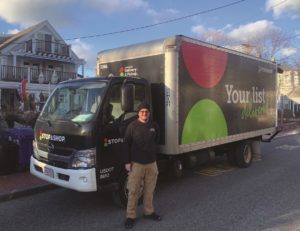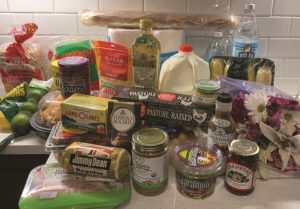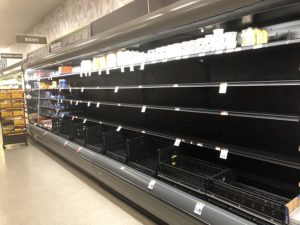PROVINCETOWN — Last September, Luther Bumps of North Truro drove from one end of the Cape to the other, taking photographs along the way. His pictures were not pretty. They were taken at seven different Cumberland Farms stations and showed gas prices rising as he progressed from Dennis, where the price was $3.55 a gallon, to Orleans, where it was $4.16 a gallon, to Provincetown, where gas that day was $4.69 per gallon.
“The price differential is certainly not because of the cost of trucking,” Bumps wrote in a letter to the editor of the Independent. “We are a captive audience, and stores tend to take advantage of our geography to extort high prices.”
Last week, inspired by Bumps’s letter, the Independent conducted a study of grocery prices.

The goal was to test whether shoppers are paying more for the same list of groceries in Provincetown than in Orleans. Because Stop & Shop has large stores in each town, the study was limited to that chain. To add a third point of comparison, the same list was also ordered on the company’s website. Neither the website nor the emailed order documents say where the truck delivering those groceries comes from — but Stop & Shop driver Nate Mros had previously told the Independent that his truck, which makes stops up and down the Cape, is loaded up near Taunton.
The comparison showed some quirky variations in pricing, but in the end, the totals were not very different. It also uncovered some frustrating supply problems.
The Stop & Shop chain, with its two large supermarkets, has an outsize presence on the Outer Cape despite locals’ loyalty to several smaller local markets like Far Land Provisions and East End Market in Provincetown, the Wellfleet Marketplace, the Eastham Superette, and Friends’ Marketplace and the Whole Food Store in Orleans.

This lack of large-scale competitors is not just a coincidence: as the Independent and the American Prospect reported early last year, Stop & Shop purchased the T-Time property in Eastham in 2013, put a deed restriction in place forbidding the sale of groceries at the property, and then resold the 11-acre parcel to the town of Eastham. The town is now planning a mixed-use development on the property, but no “sale of food for off-premises consumption” will be allowed there.
Stop & Shop has placed similar deed restrictions on large parcels in Harwich, Quincy, Halifax, and other towns in New England, according to the Prospect and the Boston Globe.
The Comparison
We drew up a list of 28 items, including ingredients for breakfast, lunch, and dinner; made specific brand and size selections at StopandShop.com; and then tried to buy the exact same brands and sizes in the Orleans and Provincetown stores. In almost all cases, it was possible to buy the same item in all three places — although since the online order came first, it affected the selections.
An initial finding was that there are many fewer options online than in the physical stores. The difference was especially noticeable in the bakery department, where there were almost no fresh-made products online, and in the pharmacy, which had brand-name drugs but very few generic options. There were also fewer specialty cheeses online and no house-made guacamole — a real loss, because Stop & Shop makes surprisingly excellent guacamole.

Two items had to be removed from our shopping lists due to lack of availability: the Orleans store was fresh out of eggs. And neither Orleans nor Provincetown had fresh basil.
With those items removed, however, and a bare minimum of substitutions made otherwise, the results were rather surprising: there was almost no difference in the final bill. Individual items varied considerably across the three locations. But once added together, the list of 26 remaining items came to $139.89 online, $144.05 in Orleans, and $144.03 in Provincetown.
Olive oil was on sale online and so were flowers — but some other items were discounted in the physical stores, such as Jimmy Dean sausage, Cafe Bustelo coffee, and Brianna’s balsamic salad dressing. A seven-dollar delivery charge brought the gap between the stores and the online shop to less than five dollars.
Between Provincetown and Orleans, a few items were more expensive in Provincetown: minced garlic, French bread, salted butter, and paper towels. These differences were wiped out by availability in the produce department, however. Provincetown had only organic limes on Dec. 31, and Orleans had only organic strawberries, and the premium prices for these ingredients overwhelmed the 10-, 20-, and 40-cent differences in the rest of the store.

For most of the 26 items in our cart, in fact, the two physical stores had the same price. The biggest single difference on an identical item was 70 cents on a 750-ml. bottle of olive oil.
For Ken Pratt, who was shopping at the Provincetown store on Dec. 31, availability was as much a concern as price.
“All the prices have gone up, and some things are just so volatile,” said Pratt, who said he’s been shopping here for 20 years. “Coffee, and especially bacon — the price is just all over the place.
“That said, what’s really hard is when something just isn’t here,” said Pratt. “I’ve been here when there’s no dog food at all. Bread, or produce — things will just be entirely missing now.”
Provincetown had a full case of eggs that day, with seven different brands to choose from, while Orleans had no eggs of any kind.
With price differences between the stores being less than expected — at least for this list of groceries — what turned out to be the biggest variable in our shopping trips was whether products were even available.
